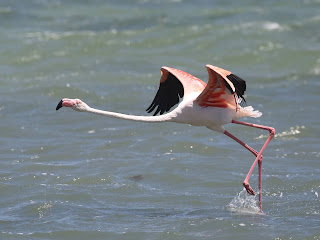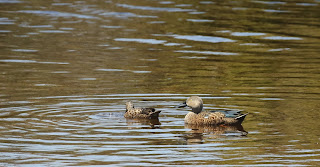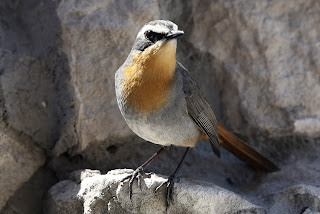This was a new destination for me. I had long wanted to visit, but somehow had never managed it, often driving straight by on the way to somewhere else! Delana had of course been there many times before! We suddenly had a few days free, as our UK freight was delayed yet again! So early on 7th February we set off for the three hour drive to the West Coast National Park.
The lovely manor house at Geelbek.
Large tracks of saltmarsh & reedbeds.
Geelbek Hide
Greater Flamingo
311 birds were present today.
It was high tide so nearly all the waders had left.
The hide affords fantastic close up views.
Abrabhamskraal Hide
This is the only area of freshwater in the park.
African Sacred Ibis & African Spoonbill
White backed Mousebird
The view from inside the cottage.
Cape Francolin, very common here.
Speckled Pigeon

Eating snails
Atlantic Viewpoint
Up early on 8th February & visited the Atlantic Viewpoint on the west side of the park. It is a scenic area, but we missed our main target species which was Karoo Lark.
Karoo Scrub Robin
as the tide rises.
The tide was rising, so we quickly moved on to the Geelbek Hide. It was an excellent couple of hours, as our timing was spot on.
signs of summer plumage.
Common Ringed Plover
Birds:
Greater Flamingo 300+; Black winged Stilt 95; Pied Avocet 99; Grey Plover 47; Common Ringed Plover 78; Whimbrel 147; Eurasian Curlew 7; Ruddy Turnstone 4; Ruff 1; Curlew Sandpiper 1800; Sanderling 82; Little Stint 580; Greenshank 21; Marsh Sandpiper 2; Osprey 1; African Fish Eagle 2.
At the viewpoint.
Large billed Lark
Our last day in the park was on 9th February & we started at the Seeberg Viewpoint. It is a very scenic spot & straight away we started seeing good birds starting with Southern Black Korhaan in the distance. It was a fine male calling, but just too far away for any meaningful photographs. We saw two more males later in the morning.
Difficult to approach & photograph.
but often difficult to find.
We then saw a couple of Large billed Larks & then hit the jackpot with at least three Karoo Larks. The Karoo Larks were quite flighty & not easy to observe.
Grey-backed Cisticola
which eventually came close.
Kelp Gull
Pasternoster, a charming little Cape coast village.
One camps right next to the sea.
We then drove to Pasternoster, a nice authentic Cape settlement on the coast. It is a pretty little spot with nice places to stay & eat. In the afternoon we visited an old haunt of Delana's The Cape Columbine Nature Reserve. It has limited diversity but is a scenic spot for camping & lounging for a couple of days.
Common Greenshank
This would be aa nice spot on the map to spend a couple of days basically doing nothing.
Saw six birds, but didn't manage a good photo!
I don't spend much time in its range.
So nice to get good views this morning.
The next morning Delana had to work, so I went birding down a little used dirt road looking for Cape Long billed Lark & Sickle-winged Chat. The conditions for birding were terrible! The wind was very strong & made life difficult. However I did see both target species well.
That was the end of our few days away along the west coast. The places were fantastic, but the constant wind was a drain. Delana says this is normal here, so camping could be interesting! We did enjoy some spectacular scenery & some great birding. We will be back!












































































































No comments:
Post a Comment